Jungle survival chief instructor Mohamad Maulana Jarau showing a trainee how to sever a water vine and drink from it.
To survive in the woods, rely on the 5Cs: Cutting tool, combustion, cordage, container and cover.
“And if you can only bring one C, make it the cutting tool,” advises outdoorswoman Nasya Nani.
With just a cutting tool, you can slice vines or strip the bark from trees to create cordage, cut bamboo to fashion containers for water or cooking, or chop palm fronds to build a shelter.
“A parang is ideal but for hikers needing to travel light, it might be too heavy. At the very least, carry a sturdy knife,” she explains.
For combustion, Nasya recommends a ferrocerium rod, which you scrape with a metal tool to produce large sparks burning at over 3,000°C.
This tool enables you to ignite a fire with nearly any tinder.
Her preferred cordage is paracord, originally designed for parachutes, which typically boasts a test strength of 250 kg.
“Paracord consists of a sheath containing at least six inner strands.
ALSO READ: One man and his bike: Malaysian camper finds peace and solitude on his solo motorbike outings
“So, even with just 1m of paracord, you can create a line up to 7m long,” she said.
Having a container for collecting water or cooking significantly enhances your survival chances.
As for the final C – cover – Nasya favours a high-quality, large black plastic bag.
“It can be easily folded into a compact size and won’t take up much space in your backpack.
“You can use it to build a makeshift shelter or even fashion a buoy to float on water.
“It serves many purposes, such as holding items and gathering foraged food,” she says.
Even on a day hike, Nasya ensures she carries the 5Cs, just in case a leisurely outing turns into a survival scenario.
This and much more was covered in a recent basic jungle survival course called Xcape, organised by Nasya’s social enterprise, Serigalax.
“After the Covid-19 pandemic, I became an avid hiker, joining experienced groups and encouraging my friends to participate,” she said.
ALSO READ: Give kids fish-catching nets while camping for hours of fun and nature discovery
“I attended outdoors courses and aimed to learn as much as I could about jungle resources and survival skills.
“Jungle survival became the next logical step after hiking, leading me to organise Xcape for others to learn as well.”
The training took place at Campsite Lasykar Gunung in Kerling, Selangor, with chief instructor Mohamad Maulana Jarau, an Iban who grew up in a longhouse in the jungles of Sarawak.
Participants learned to start a fire using two techniques: the bow drill and the ferrocerium rod.
They also identified edible plants, and learned to slaughter, gut and dress chicken before baking them in bamboo or cooking them with tapioca leaves or roasting them over an open fire.
By cutting several Bertam palm fronds and weaving their leaves, participants also constructed shelters.
“You can add the black plastic bag to the shelter for extra waterproofing and, in a desperate situation, the palm fronds are stiff enough to be stabbed together for protection against the elements,” she explains.
ALSO READ: Get up early! Pre-dawn hikes offer surprising encounters with rare critters
They also discovered how to identify “water vines” – woody vines that, when severed, will produce clean, drinkable water.
However, if you cut a vine and milky white sap oozes out, do not drink it, as it may be harmful.
Additionally, they learned how to set neck snares for trapping small animals like snakes and squirrels.
“It is an offence to snare animals in the jungle, so only do this if you find yourself in a dire survival situation and require sustenance,” Nasya cautions.
To attend the next Xcape jungle survival training, send a WhatsApp message to 017-260 2083.













